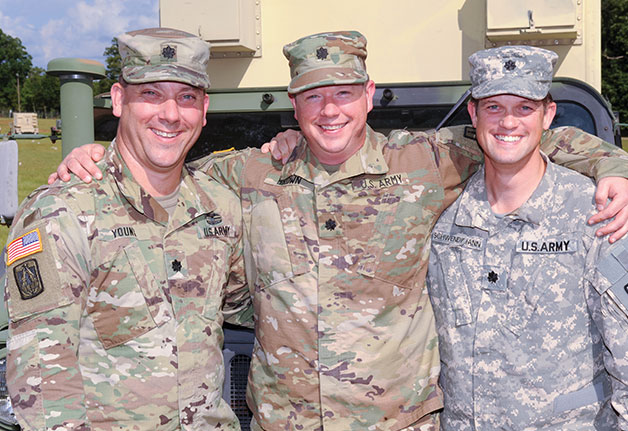Just 39 days a year. That’s the time devoted to training a complex group of citizen-soldiers who may be called upon to perform disaster-relief assistance, search and rescue operations, civil defense, homeland security, missions on foreign soil and even support for the war on drugs.
“It takes creative, dedicated soldiers who spend more than the 39 days they’re paid for,” says Lt. Col. Carl Young ’96 from a field command post near Fort Hodges, S.C. At the time he was commanding the 151st Expeditionary Signal Battalion and directing Joint Strategic Plans with the South Carolina National Guard.
He’s now stationed at the Pentagon as the Army’s chief cloud architect. This is a return to Washington, D.C., for Young, who previously served as the chief of war plans policy for the Joint Chiefs of Staff.
Joining him at Fort Hodges were Lt. Col. Chris Schwendimann ’97 and Lt.
Col. Will Brown ’97. A few hours earlier, Schwendimann was in a suit and tie as a financial planner and banker. He just rotated out of battalion command and now holds a staff position with the National Guard in Columbia. He works under the brigade command of Col. Andrew Batten ’87. As an aviator, Schwendimann serves three and four times the standard 39 days. When he’s not in uniform Brown is president of Lindsay Oil Co. At least one weekend a month and two weeks a year, however, he’s responsible for training signal troops.
“Out of the classes of 1996 and 1997, within the past year there have been four Army battalion commanders from Wofford,” says Young. “Statistically, it’s pretty rare — unless you’re talking about West Point — to have four out of the dozen or so to make battalion commander at the same time.”
In addition to Brown, Schwendimann and Young, the Class of 1996-97 battalion commanders also include Lt. Col. Bryan Lake ’97, with the Security Force Assistance Brigade, U.S. Army Forces Command, based out of Fort Bragg, N.C. Lake, who just returned from Afghanistan, is on active duty.
“We all have over 20 years of service,” says Schwendimann. “We serve because the Army still desires our service, and we still want to provide it. We do it for love of state, love of country, love of peers. It’s a fellowship, and in some cases we’re lucky enough to have developed long-term friendships.”
Young has conducted combat operations in Kuwait, Iraq and various locations around the world. Schwendimann was deployed to the Balkans twice and also has spent time with the guard in Greece, Korea and Japan. Brown did a tour in Afghanistan and connected with Lenny Best ’82, who also was serving there at the time.
“You are not going to understand or know what’s going to happen when you hit the ground, so soldiers need to be able to make immediate assessments,” says Young. “The true liberal arts education we received at Wofford helps you think quickly and effectively.” Schwendimann calls it mental agility and adds that building adaptive leaders is a challenge.
“We don’t know when or how, but there will be another shift in worldview. In our lifetime, 9/11 did that,” says Schwendimann. “Not knowing what the future looks like, how do you prepare students? I believe the answer is the liberal arts. It’s a foundation that provides a broad perspective and open-mindedness. The skills I learned at Wofford can be applied to commerce as well as national defense.”
According to Young, the cultural shift that Schwendimann mentions has led to a shift in the military as well.
“The guard has become much more integrated into active units,” says Young. “We’ve started calling ourselves operational reserves. The change hasn’t been smooth, but in the end we’re better and more flexible for it.”
Young used that Wofford ingenuity to build additional flexibility and efficiency into National Guard training. Instead of soldiers gathering at brigade headquarters and moving to field sites, a process that sometimes took four or five hours, Young set up a mobile command post in an unused field near a National Guard armory. The post has remained in place.
“We came out here for exercises and never left,” says Young. “This is how we would set up in the field. Before we had satellite equipment, networks, telephone operations, cooks and mechanics all sitting back at armories, and we couldn’t do what we needed to do. Now we have satellites pointing at the sky, and we’re doing our thing by 9 a.m.”
Young’s field model has generated 50 percent more time in actual training and has caught the attention of other states looking for ways to make their National Guard units more productive and efficient.
According to all of the 1996-97 battalion commanders, support is the key to balancing the demands of multiple jobs, sometimes additional education, and family responsibilities.
“My professional career as a civilian and my professional career in the military strengthen each other,” says Brown. “Balance can be tough, but a supportive family and a supportive work place helps, and I think we all enjoy the challenge.”
By Jo Ann Mitchell Brasington ’89
